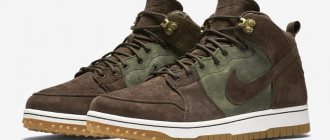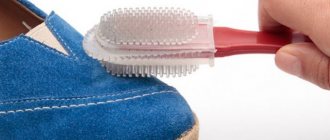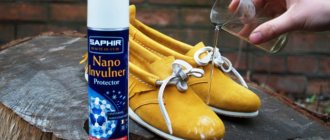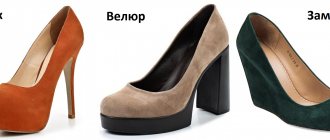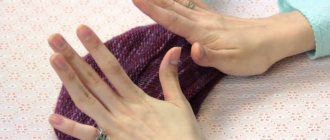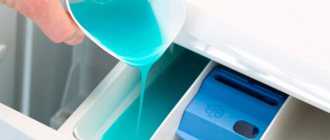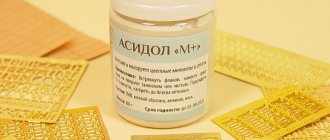Suede shoes look beautiful and prestigious. Suede and nubuck cannot be worn in rain and slush, but this does not stop fans of soft, cozy and comfortable shoes. To extend the life of your favorite pair, you need to figure out how to use a brush for suede shoes.
In addition, you can use special sprays and impregnations, but you definitely can’t do without a good brush.
What and why is needed
The disadvantage of nubuck is its missing water-repellent layer. These shoes are susceptible to liquids, so it is recommended to choose a product that will provide the necessary resistance to water. One of the most popular products is impregnation from Salamander. The mandatory list of products needed to care for nubuck includes:
- brush;
- impregnation;
- cleaning sponge;
- eraser for deep stains;
- color refreshing cream;
- special foam or cleaner.
The set of funds is not small. However, this is the only way to protect nubuck and enjoy your favorite shoes for many years.
Brushes for cleaning and polishing the top
These are the most common options. You definitely won’t be able to do without these brushes. The required minimum is one piece, but it is unlikely that you will decide to limit yourself to it. We will talk about the materials further, but here we will only note that brushes with horsehair bristles are considered the best. If we talk about sizes, then medium-sized brushes are best suited for cleaning - 13-17 centimeters long. Small ones are not so convenient.
Large brushes (20+ centimeters) are the ideal choice for polishing. The bristles on such brushes are quite long (3.5-4 centimeters) and usually less rigid than on medium-sized brushes. Large polishing brushes, perhaps, cannot be classified as a must-have, but it is still very desirable to purchase them. If you have shoes in two or more colors in your wardrobe, then ideally you will need two or three of these brushes; if you buy one, then after polishing black shoes you will have to rinse them thoroughly.
Long bristled polishing brushes
Short bristled cleaning brushes
Shoe cleaning brushes are usually rectangular in shape, but Saphir also produces oval models that can also be used for cleaning shoes, as well as for removing excess cream from seams and perforations. Large rectangular brushes are usually used for polishing.
Primary work
Once you have purchased nubuck shoes, start processing them. With the help of a protective spray, a colorless layer will appear on the surface, which will not allow moisture to penetrate the material, and dirt and salt simply will not stay on the surface. This is a kind of creation of “immunity” for shoes. The barrier will help nubuck retain its original appearance even in the worst weather.
The optimal effect can be achieved only after triple treatment. The surface is moistened with an aerosol and dried naturally far from heating devices. After 12 hours, the procedure is repeated and the same cycle is performed for the third time.
Suede brushes
Suede shoes need to be cared for differently than smooth leather shoes. We have a large article on our website dedicated to this topic, but here we note that there are special brushes for suede:
- crepe, which are useful for leveling and raising pile;
- with rubber pimples (for regular care);
- with a special pile selected specifically for suede (sometimes it is a combination of artificial pile and very thin metal) - for cleaning from dirt;
- combined double-sided (rubber bumps + metal bristles).
Burgol crepe brush
Burgol brush with brass bristles
Double-sided Tarrago brush
If you have the financial opportunity, you should give preference to products from famous companies - in particular, Saphir, Turms, Burgol. In the middle price segment, accessories from the Spanish brand Tarrago can be a good choice.
Dealing with stains
To remove dirt, it is recommended to purchase a special eraser. The material used for its manufacture is a mixture of rubber and foam rubber. With the help of such an eraser you can take care of not only nubuck shoes, but also suede ones.
The advantage of an eraser is that it effectively removes dust, dirt and stains. Moreover, an eraser can sometimes help in dealing with minor scratches. The smooth surface of the eraser allows for cleaning, while the rubber side performs polishing. The rough side of the eraser contains a material that helps get rid of stubborn stains and grease stains.
Some products use a foam texture. Foam is able to remove dirt from objects even after its absorption process has completed. Most often it is offered in aerosol form. Use requires preliminary vigorous shaking. The surface with the stain is covered with foam, and removal is carried out with a special sponge. The use of foam is also rational for cleaning internal surfaces. There is no need to rinse off such compositions with water.
Which side should you clean suede and which side should you clean nubuck?
The device with a triple surface is the most popular and is chosen most often. But many people have a logical question: which side of the brush to clean suede, and which side to clean nubuck? Let's look at each of them in turn.
- The side with nylon nap and brass wire is for napping. Mostly it is suede, but there is also long-haired nubuck. Metal bristles lift the leather fluff, as a result, the shoes are carefully cleaned of dust and stains, and shiny areas are smoothed out.
- The rubber side (or rather rubber side) is ideal for nubuck surfaces, but can also be used for suede. Like an eraser, it erases dirt and small scratches. In addition, the brush gently polishes the noble leather, maintaining its velvety and matte shine.
- The ribbed protrusion is designed to clean seams, zippers, and small decorative parts from dirt. Very comfortably!
We recommend: What are safe smells that repel cats so that they don’t shit?
Tools at hand
Sometimes you don’t have a professional cleaning product at hand, everything ends unexpectedly at the most necessary moment, but you still need to put your shoes in order. In such cases, one should not forget about folk recipes, most of which are focused on the use of funds available in the house of any housewife. However, do not forget about the preliminary check in an inconspicuous area.
Steam cleaning of suede and nubuck is excellent. You can use a steam generator or simply hold your shoes over a pan of boiling water for a few minutes. Usually, after such treatment, dirt can be easily removed with a special brush.
For cleaning delicate materials, a soap solution is suitable, to which a teaspoon of table vinegar is added per liter of water, and ammonia in a ratio of one to five to water. The surface treated with this product is washed with cold water, and a soft cloth is used for polishing.
To improve the external characteristics of shoes, it is recommended to use an alcohol solution, for which water and alcohol are mixed in equal proportions. A cotton pad soaked in the mixture is suitable for treating the external surface.
To disguise the greasy stains that appear on nubuck, sprinkle them with talcum powder for a couple of hours, then carefully brush them. For delicate materials in brown tones, a brush pre-moistened in the grounds remaining after coffee brewing will serve well. Black shoes made from delicate materials can be restored to their original appearance by lightly wiping them with black copy paper.
Choosing the right brush (based on material)
Pile models are designed for cleaning any shoes. Their bristles can be either natural or artificial.
Since artificial bristles are intended for rough cleaning, they are not suitable for delicate suede material. It can effectively clean rough surfaces or old material. The natural bristles of pile models can be hard or soft. Soft bristles are the hair of a horse or badger. It gently cleans delicate materials. Stiff boar bristles are best used for dry processing of durable suede products and leather shoes.
A variety such as a rubber brush has already been mentioned. It is made of vulcanized silicone material that has been subjected to special processing. The silicone model is used to clean greasy areas and grease stains. With its help, they take care of the pile, lifting and smoothing it.
General care tips
For nubuck and suede, daily cleaning with a special brush is required. About two to three times a week, if the wear is constant, you will have to resort to procedures related to restoring the appearance, which will mask abrasions, refresh the color and renew the anti-water impregnation.
To perform a classic care cycle, dry your shoes. This can be easily done by stuffing the liner with newspaper or inserting absorbent wooden blocks inside. It is important to clean up stains after they have dried. Fresh dirt can penetrate even further. Avoid drying with a hair dryer or near heating sources. This will cause cracks and deformations. It is not recommended to use dryers special for shoes.
After drying, remove dust and light dirt from the surface. Dry shoes involve working with a dry brush; stubborn dirt is removed with a special eraser. After the shoes have returned to their original appearance, do not forget to treat them with a special spray that repels water and dirt. If abrasions appear, you can’t do without spray paint.
Features of suede brushes, are there any differences from regular ones?
Suede brushes look similar to regular brushes, but have many differences. Often, these cleaning products have tubular rubber teeth instead of bristles, and the reverse side consists of steel teeth placed in a special order. With their help, you can not only clean dirt, but also straighten the pile, remove grease stains, and hide scratches. Sometimes a suede brush may have an additional protrusion for high-quality cleaning of seams and shoe soles.
It is not recommended to clean suede shoes with ordinary brushes. Otherwise, the pile can quickly fade, lose volume and have a matte finish.
Brushes for cleaning soles
Large triangular or square brushes can be used to clean the soles. The lint does not play a special role here - it can also be synthetic. In principle, you can do without such a brush, but it obviously won’t be superfluous. Rubber soles, of course, can be carefully washed with water (without touching the tops of shoes or boots), but it is strictly not recommended to wash leather soles under running water.
Solemate brush for cleaning soles
Lubricating brushes
These accessories are used to apply cream and distribute it over shoes. They are not mandatory - if you wish, you can apply the cream with your hands (which should preferably be protected with gloves if the cream is not colorless) or with a cloth. It's a matter of taste.
Spreading brushes often have a round shape and are equipped with a fairly long handle. The bristles of the best specimens are made from horsehair. These types of brushes are convenient for distributing cream over the shoe, but “getting” cream out of the jar is not always convenient (depending on the jar and how much cream is left in it). Occasionally you come across very compact brushes that fit perfectly into the jar (Saphir has such a model), but they are less suitable for spreading cream over the shoe and rubbing cream into the shoe.
Burgol brush
It is especially worth noting that if you decide to apply the cream using a spreading brush, then you will need several such brushes. Exactly how much depends on what shoes you have in your wardrobe. If only black and dark/medium brown, you will need two brushes. If there are also light models and/or models of other rather dark colors, three or more brushes will be needed. Of course, you can try to get by with just one lubricating brush, but washing the cream out of it every time is a long, unpleasant task, and besides, it will not give an ideal result.
Brushes for cleaning and treating welts
To clean the welt you need to use special brushes that resemble toothbrushes. Accordingly, in a pinch, you can use a regular toothbrush, but keep in mind that its bristles are designed specifically for teeth, and not for shoe welts. In addition, cleaning the welt with a toothbrush is unlikely to bring aesthetic pleasure.
Saphir welt brush
With the same brush you use to clean the welt, you can apply grease, cream or other products to the welt. Of course, after cleaning it should be carefully rinsed and dried. This must also be done if you only have one brush for cleaning the welt, and among your shoes there are models with both light and dark welts.

